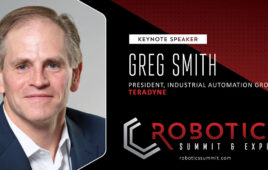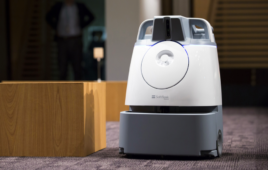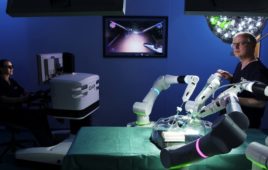
The Swift picker is an example of how mobile robots are evolving to meet customer demand. Source: IAM Robotics
Growing demand for rapid e-commerce order fulfillment is a major driver for the development and adoption for mobile robots. However, the market and the technologies that serve it are changing rapidly.
The Robot Report asked the following four experts in mobile robotics about their observations (their responses have been edited for length):
- Tom Galluzzo, founder and chief technology officer at IAM Robotics.
- Fergal Glynn, vice president of marketing at 6 River Systems Inc.
- Karen Leavitt, chief marketing officer at Locus Robotics
- Daniel Theobald, chief innovation officer at Vecna Robotics
- Bruce Welty, CEO of Quiet Logistics and former board member of Locus Robotics
 Keynotes | Speakers | Exhibitors | Register
Keynotes | Speakers | Exhibitors | Register
We’ve all talked about the “Amazon effect.” How are major e-commerce retailers, logistics companies, and suppliers dealing with competitive pressures? Can you give examples?

Tom Galluzzo, CTO, IAM Robotics
Galluzzo: Reactions are all over the map — some people and companies have thrown up their hands: “We’re never going to do $1 billion of automation.” They’re trying to find their own niches.
Some bigger retailers are going head to head. They’re trying to see two to five years down the line, when there will be new kinds of physical stores. There are lots of “dark store” and drive-through initiatives being formulated for the next 10 years.
Still others, mom-and-pop companies in e-commerce, are not yet looking at mobile robots. Remember that Amazon represents only 20% of e-commerce, so eBay, Google Shopping, and others are still relevant channels. A lot of vendors are selling on them and don’t scale — or realize they’re ready for automation.
Glynn: The labor market is still the predominant challenge we hear about. Whether it’s migration, lack of available local workers, or competitive salary pressures from other local warehouses, retailers and logistics companies are looking for ways to make up for this challenge.
We are seeing the market use collaborative robots, not only as a way to differentiate services from a business development perspective, but also from a hiring and retention perspective.
As an example, I was at a distribution center in Orlando recently, and I overheard one of the associates excitedly telling his family, who had come to pick him up, about the collaborative mobile robot called “Chuck” he was working alongside that day.
Welty: Amazon keeps raising the bar, and along with that, the expectations of the consumer: exceptional customer service, omni-channel options, Prime, and now “choose your day.”
Leavitt: In addition to price pressures, particularly by dint of its economies of greater scale, Amazon has raised consumer expectations around shipping and delivery times.
Retailers and 3PLs [third-party logistics providers] are competing in a variety of ways. In particular, they’re working to ensure a seamless experience from click to delivery. The retailer’s brand elements are preserved. Not just outer packaging, but also individualized handling of the merchandise. Merchant-specific dunnage, personalized inserts, frequent customer promotions, etc. are incorporated into the packaging.
Theobald: More than ever before, consumers want to be able to purchase a wider variety of goods online, they want to spend less for them, and of course they want them delivered to their door quickly. This has put pressure on the major players to adapt their operations to handle things like carpets, kayaks, exercise bikes, and tires, where previously small things like books were the norm.
Mobile robots provide an attractive option to oversized conveyors due to the low upfront costs and the inherent flexibility in the technology to adapt to the user’s changing needs.
There are numerous other benefits. Changing the route of a conveyor takes months, while changing the route of a Vecna Robotics unit takes minutes. Robotic equipment lasts longer than manually driven units, and facility damage, inventory damage, and injuries are almost completely eliminated.
How have mobile robot capabilities improved in the past year?

Fergal Glynn, VP of marketing, 6 River Systems
Glynn: In short, it’s software advances. Unlike traditional automation, which depreciates from the moment you install it, a robotic system can actually get better day after day, thanks to improvements in the artificial intelligence and machine learning that powers it.
Galluzzo: Mobile robots are getting better, and there’s greater awareness of what they can do. It’s more of a commoditization of software. There are more open-source, commercial APIs for mobile autonomous robots.
Think of NVIDIA Isaac, which provides a set of algorithms, nuggets for autonomous robots. That’s helpful for technology to climb the curve. Other examples include Brain Corp. and CMU spinout Bito Robotics.
Welty: They are better in nearly every way. Mapping is faster and more robust, navigation is better, localization is much tighter. It is now possible to add more context to the map, such as one-way aisles, stop signs, and speed zones.
There is a lot of machine learning and AI that intelligently combines orders and clusters picks with workers. This clustering is so effective that it was necessary to dumb it down to avoid congestion in the aisles.
Leavitt: Not only does the hardware continue to improve, but the operating intelligence of mobile robots has also come a long way. The navigation and motion of the robots are dramatically more fluid now than just a year ago. The robots are able to make more nuanced decisions about automatic rerouting due to congestions and dynamic changes in the warehouse.
There have also been a number of advances in the user experience, as well as in the operational insights. The user interface continues to evolve to support shorter adoption times and higher productivity in picking.
As we gain knowledge through making millions of picks, we are able to benefit from that experience in our dashboards, reports, and optimization routines. Virtually every element of the technology stack continues to evolve at a rapid pace.
Theobald: While mobile robot capabilities have improved across the board, including navigation, safety, better user interfaces, and better orchestration of the fleet, the biggest improvement has come from fine-tuning robot applications to user needs.
I think it’s better integration of the whole robotic system into appropriate use cases and better dealing with the real world, which is messy. Learning how to integrate these systems into daily operations — what works, what doesn’t work — has really been the key to the great progress over the past year.
What component technologies do you think need to develop more or become cheaper?
Galluzzo: All of them. Definitely robot arms — they’re still just a little too pricey for what we get out of them. Arms are our biggest line item in our bill of materials. I understand why they’re at the price points they’re at, since they’re hard to make, but market requirements need better returns for justifying robots.
Sensors and cameras have definitely come a long way, but motors and controls are not changing too much in terms of cost. I think embedded computing GPUs will come down.
Glynn: We are seeing improvements in component technologies across the board from both a software and hardware perspective.

Bruce Welty, CEO, Quiet Logistics
Welty: All of them. Multi-plane, solid-state lidar is making great strides. 3-D time-of-flight and 2D cameras are continuing to improve. You can either pay the same for better tech or pay less for the same tech.
Leavitt: We are benefiting from the advances being driven by the automotive industry. As with other types of technology, Moore’s Law applies. We have the option of holding costs and increasing functionality, or holding functionality and dropping costs. We may eventually start to see bifurcated product lines as standard and premium products evolve.
Theobald: Safety-rated sensors tend to be one of the biggest cost drivers. Seeing more options at economical prices would be a big push forward in the industry.
Performance Level D lidar, for example, are one of the biggest single cost drivers. I don’t like industry being tempted to make risky trade-offs between safety and cost. In a perfect world, a reasonably priced safety-rated 3-D sensor would be amazing. If someone builds that, I will buy a large number of them!
What sorts of requests do e-commerce companies have? Are you able to meet them, or is it a matter of developers and users adjusting expectations?
Galluzzo: Companies are really looking for what the RightHand Robotics guys call the “three Rs:” range of products, the picking rate, and reliability for restocking.
Many requests are on the range piece. Customers really want to see robots capable of handling more types of things, taking on different tasks than can do today. We’re able to meet their requirements in a certain range — for example, 80% of SKUs — but that’s a very broad spectrum of things to handle.
Welty: They all want “rule of thumb”-type answers. How many robots per person, how many robots per square feet, how many picks per hour can I expect?
We continue to refine our thinking, and the answers are getting better. It’s still early in [the process of] understanding just how effective and efficient AMRs can be. We’re only just starting the optimization process.

Karen Leavitt, chief marketing officer, Locus Robotics
Leavitt: We work very closely with our customers to properly assess a site’s fit and needs and to optimize the deployment. We continuously plow those learnings back into the product.
We also have customers who, once they see the boost in productivity in their picking function, naturally want to apply these advances to other warehouse functions.
Theobald: We’re seeing more and more process integration with the whole enterprise. It used to be that having a robot that could do one thing pretty well was good enough. Customers now really need their robots to be multipurpose.
Vecna’s mobile robots can be dynamically assigned to different tasks in real time based on the current needs of the operation. We need to build robots and systems that provide value 24/7 to our customers whenever possible. If we want to help the industry advance, we can’t have robots sitting idle.
One of the challenges that the industry faces right now is that we are in a hype cycle around robotics; hence, you see unrealistic claims and misinformation that seems to be inspired more by Hollywood than reality. When robotics companies fail to deliver, it can lead to incorrect perceptions that mobile robots aren’t ready for prime time. We’ve seen something similar in the self-driving car industry.
However, many customers are already seeing the benefits of mobile robots. It’s important to buy from organizations that have a proven track record of delivering safe, reliable robots that provide real ROI.
Where do you expect the most demand for mobile robots this year?
Galluzzo: We’re still growing in the health and beauty e-commerce world.
There’s new demand in grocery sector. That’s going to be a continuous change over a long time. Groceries is the biggest time sink for shoppers in the country today. We spend 40 billion hours in the U.S. shopping for groceries, the equivalent of 20 million full-time jobs. Since we’re at “full employment” levels, if we want to do this, we’ll need a whole lot of robots.
Glynn: We announced general availability in Europe at LogiMAT in Stuttgart in February of this year. We were amazed at the interest from the show attendees. The demand for flexible and affordable automation in Europe is just as strong as in the U.S.
Welty: 3PLs, European companies, and large brands that have decided to get serious about e-commerce.
Leavitt: The problem is worldwide — anywhere labor shortages are a constraint on growth. I expect we will also see demand from some industry verticals not necessarily associated with e-commerce, such as medical devices and automotive parts distribution.
Theobald: We’re seeing a pretty big uptick in demand for our pallet-handling robots. Our robots are able to find the right pallet, which doesn’t need to be perfectly positioned, and then pick it up and deliver it wherever it is needed. We’re also seeing tremendous excitement around our automated case- and tote-handling systems.
Have trade tensions with China or uncertainty with Europe affected robotics demand in the U.S.?
Galluzzo: We haven’t felt it yet. [The U.S. is] a big, slow-turning ship, and it will take a while before we see a big impact.
However, China is schooling the U.S. when it comes to investing in artificial intelligence and automation. The government over there is writing robotics a pretty big blank check. It could bite them later, but it’s still impressive.
The driverless car industry is an anomaly. The hype wave has built up, but I’d love to see one or two of our competitors in mobile robots get acquired for $1 billion.
Welty: Yes. Component and subassembly costs have risen. EU regulators are getting more involved in AMRs. Economic uncertainty never helps. Tariffs seem to be hurting [industry], but it’s hard to know how much.
Leavitt: On top of this uncertainty, there remains the specter of intellectual property theft or infringement. We have seen a tremendous amount of interest from China but are reluctant to entrust our IP to a partner in that market. Notwithstanding Brexit, there appears to be a lot of market demand in the EU, as well as in the U.K.

Daniel Theobald, chief innovation officer, Vecna Robotics
Theobald: We’re seeing continued strong demand in the U.S. and Europe. We’ve decided to focus primarily on the U.S., but we have international customers with operations around the world, and we support them wherever they do business. We’re really busy scaling with large customers right now, so if there is an impact, it isn’t affecting us significantly.
As people become more comfortable with robots in multiple roles, do you expect job fears to subside?
Galluzzo: All of the doomsday predictions are kind of a good public-service announcement. It’s a warning to kids not to get jobs in manual labor but to go into computer science.
If you’re not in robotics, learn how to build them. There are not enough people to do computer vision, AI, or software.
IAM Robotics will have a dozen positions open at any given time for next 12 to 18 months.
Glynn: There is always going to be a fear of the unknown. As people become comfortable with robots in certain roles, then the discussion will shift to other roles. The reality is supply chain, logistics, and warehouses are tremendously complex.
For the foreseeable future, we see collaborative and flexible robots, that is, robots working alongside humans to make the job easier, safer, better, as the automation technology of choice for logistics operators.
Welty: Yes. We are seeing much quicker decision making. Customers are becoming more confident in the technology. The natural career movement of key executives with positive robot experiences is creating more opportunity as they bring the technology into their new companies.
Leavitt: We are seeing mobile robots welcomed by warehouse workers. For now, the overall growth in the space offsets any real risk to workers. Moreover, our robots are designed to make work better, so the workers are seeing improvements in their own skills while being relieved of much of the drudgery of warehouse piece handling.
Theobald: I think so. This all comes down to a fear of the unknown. As people start to work alongside robots on a daily basis, these fears quickly evaporate. Like any technology revolution, the predictions of mass unemployment are eventually proven wrong.
Robots are just like any another automation technology that can improve productivity and improve the quality of life of workers and consumers.
People have a hard time imagining the future — they tend to overestimate the negative and underestimate the positive. For instance, both ATMs and automated switchboards provoked fears of massive unemployment, which did not happen. But without automated switchboards, we wouldn’t have the Internet now.
Filed Under: AI • machine learning, The Robot Report, Robotics • robotic grippers • end effectors





Tell Us What You Think!